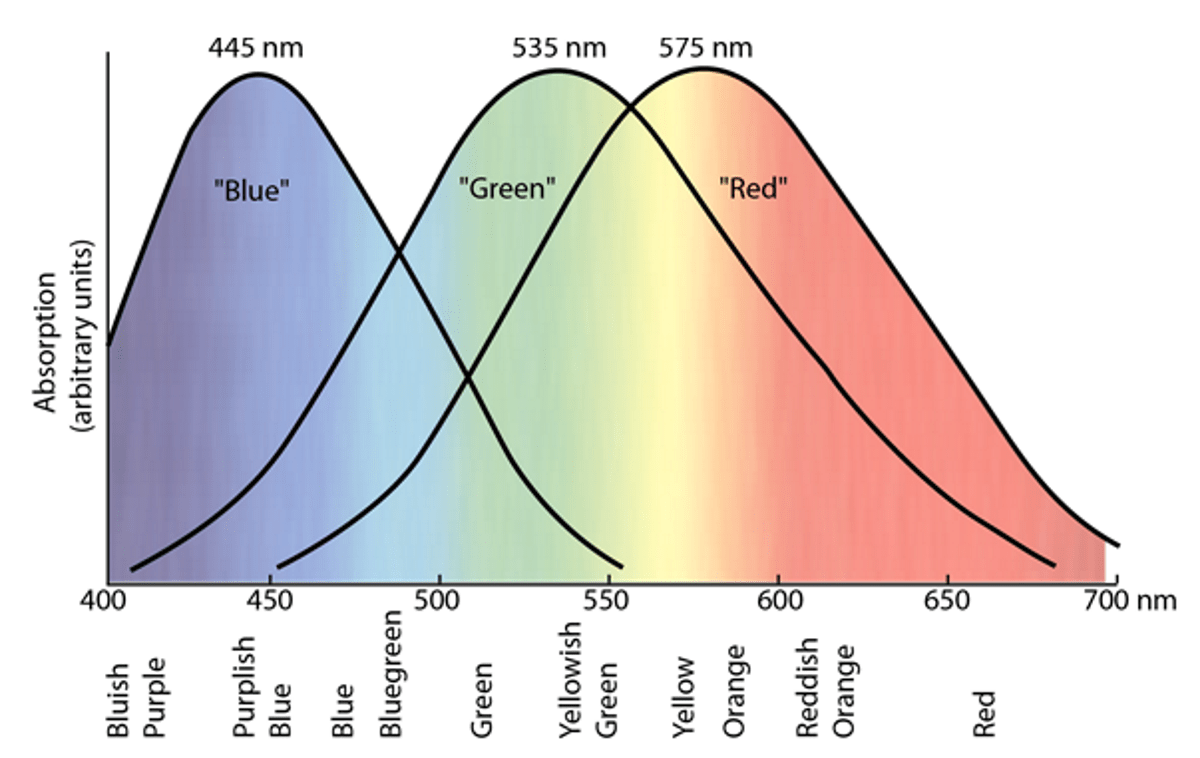The Many Types of Color Blindness
Most people have heard of ‘color blindness’ before – but did you know it can come in many forms?
In simple terms, color blindness causes you to perceive colors differently from how most other people do. People who have it may struggle to differentiate between specific colors.
But because there are lots of different types of color blindness, it can affect someone’s color vision in very different ways.
How does color vision typically work?
Light passes through the eye to the retina (the light-sensitive layer at the back of your eye). The retina contains photoreceptors, which capture and convert light into electrical signals for your brain (this is called phototransduction). There are two types of photoreceptors responsible for your vision:
- RodsThese photoreceptors are responsible for vision in low-light conditions and allow you to see in black and white.
- ConesUnlike rods, cones are responsible for vision in higher light conditions and allow you to see color vision.
There are three different types of cones which are responsible for detecting different wavelengths of light (and thus different colors):
- S-cones (short wavelengths)These detect blue and purple colors.
- M-cones (medium wavelengths)This cone type allows you to see green-based colors.
- L-cones (long wavelengths)These help you see red-based colors.
These cones work together to provide us with a spectrum of colors. For example, when the L-cones are stimulated more than the S- and M-cones, we see red. However, when both L-cones and M-cones are activated, we see a yellow or orange color.
So, how does color blindness work?
We often mistakenly use the term color blindness to describe people who have color deficiencies. A color deficiency occurs when someone is missing one or multiple cone photoreceptor types. This causes colors to appear differently than normal and can cause confusion between colors.
For example, someone with red-green color blindness will struggle to differentiate between red and green colors.
True color blindness is when a person has no cone photoreceptors, and instead only has rod photoreceptors. These individuals have achromatopsia (also known as rod monochromacy) and can only see in black and white. This type of color blindness is very rare.
People with normal color vision have trichromacy. This is when all three of their cone photoreceptor types function properly, allowing them to properly distinguish between different colors. People with trichromacy are called trichromats.
Different types of color blindness
There are many different forms of color deficiency – some are caused by faulty photoreceptors, while others are caused by a photoreceptor type missing completely.
Color vision deficiencies caused by faulty photoreceptors
Some people have all three cone types, but some are faulty (called anomalous trichromacy). If you have this, one of your cone types will perceive light a little differently than normal. This deficiency functions like a spectrum; your vision could range from nearly normal to almost no perception of red, green, or blue colors. These types of color blindness include:
- Protanomaly (red-green color deficiency type 1)This is a type of red-green color blindness that makes it difficult to see red colors. This issue affects the L-cones, reducing your sensitivity to red light. Protanomaly can cause you to confuse red and green, and brown and orange colors.
- Deuteranomaly (red-green color deficiency type 2)This is another type of red-green color blindness that makes it difficult to see green colors. Deuteranomaly is the most common type of color blindness and affects the M-cones. If you have deuteranomaly, you will confuse red and green, and brown and orange colors. You may also struggle to distinguish blue and purple colors too.
- Tritanomaly (blue-yellow color deficiency)This type of color blindness reduces your sensitivity to blue light and makes it difficult to detect blue colors. Tritanomaly happens when your S-cones function poorly. This type of color blindness is very rare. If you have tritanomaly, you will struggle to distinguish blue from yellow, and purple from red.
Color blindness caused by missing photoreceptors
Other people may only have two functioning cone types, which is called dichromacy. Types of dichromacy include:
- Protanopia (red-green color blindness type 1)People with protanopia do not have L-cones. This causes confusion between black and red, blue and red, and green and orange colors. Protanopes also struggle to distinguish dark brown colors from black, dark green, dark red, dark orange, and dark blue colors.
- Deuteranopia (red-green color blindness type 2)This happens when you do not have M-cones. Deuteranopia causes you to confuse red and green, green with yellow, and blue-green with gray and pink.
- Tritanopia (blue-yellow color blindness)If you have tritanopia, then you do not have S-cones. This causes confusion between pale blue and gray colors, as well as dark purples and black, and green with blue, orange, and red colors.
Finally, it is extremely rare but possible to have only one type of functioning cone type. This is called monochromacy. Monochromacy (achromatopsia) is very rare and causes you to see in black and white. Your vision will comprise of different shades of gray.
Commonality of each type of colorblindness
Some types of color blindness are inherited, while others are acquired due to eye or health conditions, medications, and eye or brain damage. Here are some statistics about how common color blindness is:
- Color blindness affects 2.5% of the world population – this is roughly 300 million people.
- 8% of men (1 in 12) and 0.5% of women (1 in 200) have color vision deficiencies.
- Most cases of color blindness are inherited, but they can also be caused by diseases, drugs, or injury.
- Approximately 40% of people with color blindness are unaware that they have an issue when they leave school.
- About 60% of colour-blind people experience difficulties in their everyday lives.
You are at more risk of color blindness if you have:
- Family history of color blindness.
- Eye conditions such as glaucoma or AMD (age-related macular degeneration).
- Caucasian ethnicity.
- Health conditions that affect the brain or nervous system, such as MS (multiple sclerosis), diabetes, or Alzheimer’s disease.
- Medications such as Plaquenil.
- Eye or brain damage.
Why the disparity between men and women?
Men are much more likely to have red-green color blindness than women. This is because red-green color blindness is inherited on the X chromosome. Males have one X and one Y chromosome (XY), whereas females have two X chromosomes (XX).
If a biological male inherits an X chromosome with red-green color blindness from their mother, then they will have a 100% chance of having the color deficiency. However, for a biological female to inherit red-green color blindness they must inherit two X chromosomes with the gene (one from each parent). If a female only gets one color deficiency X chromosome, then they will simply be a carrier of the condition. This means that they will pass the color blindness to their sons.
Can color blindness be cured?
While there is no cure for color blindness, many people adjust to it over time. If your color blindness is affecting how you function, then you may consider special glasses and contact lenses or visual aids. These specialized lenses can help you to distinguish between colors better, and visual aids (such as apps) can tell you the color of items if you take a photo.
Children with color blindness may need extra help or altered learning materials during classroom activities.
How can you know if you’re color blind?
If you have color blindness, then you might struggle with:
- Distinguishing between different colors.
- Telling the difference between different shades of a color.
- Seeing how bright colors are.
People who are born with color blindness actually often don’t realise that they are color blind. This is because they have adapted to the way that they see the world.
Some symptoms you might experience with more severe color blindness include:
- NystagmusThis condition causes your eye to repeatedly move side to side uncontrollably. Because the constant eye movement makes it difficult to focus, people with nystagmus often have reduced vision and poor depth perception (ability to see in 3D).
- PhotophobiaThis is when you are light sensitive, and struggle with bright environments.
The only way to know for sure if you’re color blind is by having an eye examination. If you have any of the above symptoms, or if you have had any changes to your color vision, then you should see your optometrist for a check on your eye health.

Written by:
Dr. Jordan Marr



















